Related Research Articles
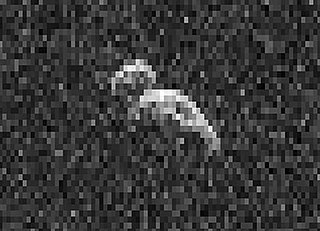
A near-Earth object (NEO) is any small Solar System body orbiting the Sun whose closest approach to the Sun (perihelion) is less than 1.3 times the Earth–Sun distance. This definition applies to the object's orbit around the Sun, rather than its current position, thus an object with such an orbit is considered an NEO even at times when it is far from making a close approach of Earth. If an NEO's orbit crosses the Earth's orbit, and the object is larger than 140 meters (460 ft) across, it is considered a potentially hazardous object (PHO). Most known PHOs and NEOs are asteroids, but about 0.35% are comets.

A meteor shower is a celestial event in which a number of meteors are observed to radiate, or originate, from one point in the night sky. These meteors are caused by streams of cosmic debris called meteoroids entering Earth's atmosphere at extremely high speeds on parallel trajectories. Most meteors are smaller than a grain of sand, so almost all of them disintegrate and never hit the Earth's surface. Very intense or unusual meteor showers are known as meteor outbursts and meteor storms, which produce at least 1,000 meteors an hour, most notably from the Leonids. The Meteor Data Centre lists over 900 suspected meteor showers of which about 100 are well established. Several organizations point to viewing opportunities on the Internet. NASA maintains a daily map of active meteor showers.

(29075) 1950 DA is a risk-listed asteroid, classified as a near-Earth object and potentially hazardous asteroid of the Apollo group, approximately 1.3 kilometers in diameter. It once had the highest known probability of impacting Earth. In 2002, it had the highest Palermo rating with a value of 0.17 and a probability of 1 in 306 (0.33%) for a possible collision in 2880. Since that time, the estimated risk has been updated several times. In December 2015, the odds of an Earth impact were revised to 1 in 8,300 (0.012%) with a Palermo rating of −1.42. As of December 2024, it is listed on the Sentry Risk Table with the highest cumulative Palermo rating of -0.92. 1950 DA is not assigned a Torino scale rating, because the 2880 date is over 100 years in the future. As of the 19 December 2024, the odds of an Earth impact are 1 in 2,600 (0.039%).

Comet Encke, or Encke's Comet, is a periodic comet that completes an orbit of the Sun once every 3.3 years. Encke was first recorded by Pierre Méchain on 17 January 1786, but it was not recognized as a periodic comet until 1819 when its orbit was computed by Johann Franz Encke. Like Halley's Comet, it is unusual in its being named after the calculator of its orbit rather than its discoverer. Like most comets, it has a very low albedo, reflecting only 4.6% of the light its nucleus receives, although comets generate a large coma and tail that can make them much more visible during their perihelion. The diameter of the nucleus of Encke's Comet is 4.8 km.

46P/Wirtanen is a small short-period comet with a current orbital period of 5.4 years. It was the original target for close investigation by the Rosetta spacecraft, planned by the European Space Agency, but an inability to meet the launch window caused Rosetta to be sent to 67P/Churyumov–Gerasimenko instead. It belongs to the Jupiter family of comets, all of which have aphelia between 5 and 6 AU. Its diameter is estimated at 1.4 kilometres (0.9 mi). In December 2019, astronomers reported capturing an outburst of the comet in substantial detail by the TESS space telescope.

12P/Pons–Brooks is a periodic comet with an orbital period of 71 years. Comets with an orbital period of 20–200 years are referred to as Halley-type comets. It is one of the brightest known periodic comets, reaching an absolute visual magnitude of about 5 in its approach to perihelion. Comet Pons-Brooks was conclusively discovered at Marseilles Observatory in July 1812 by Jean-Louis Pons, and on its next appearance in 1883 by William Robert Brooks. However it has been confirmed 12P/Pons–Brooks was observed before the 19th century.

Sentry is an automated impact prediction system started in 2002 and operated by the Center for Near Earth Object Studies (CNEOS) at NASA's Jet Propulsion Laboratory. It continually monitors the most up-to-date asteroid catalog for possibilities of future impact with Earth over the next 100+ years. Whenever a potential impact is detected, it will be analyzed and the results immediately published by CNEOS. However, alerts do not imply certainty about future impacts, as the small amounts of optical data that can trigger an alert are not enough to conclusively identify an impact years in the future. In contrast, eliminating an entry on the risk page is a negative prediction.
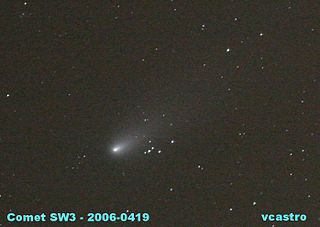
73P/Schwassmann–Wachmann, also known as Schwassmann–Wachmann 3 or SW3 for short, is a periodic comet that has a 5.4 year orbital period and that has been actively disintegrating since 1995. When it came to perihelion in March 2017, fragment 73P-BT was separating from the main fragment 73P-C. Fragments 73P-BU and 73P-BV were detected in July 2022. The main comet came to perihelion on 25 August 2022, when the comet was 0.97 AU from the Sun and 1 AU from Earth. It will be less than 80 degrees from the Sun from 25 May 2022 until August 2023. On 3 April 2025 it will make a modest approach of 0.3 AU to Jupiter. 73P will next come to perihelion on 23 December 2027 when it will be 0.92 AU from the Sun and on the far side of the Sun 1.9 AU from Earth.
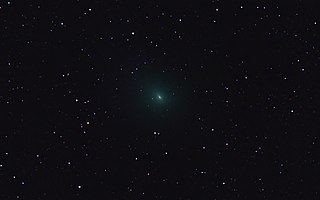
45P/Honda–Mrkos–Pajdušáková is a short-period comet discovered by Minoru Honda December 3, 1948. It is named after Minoru Honda, Antonín Mrkos, and Ľudmila Pajdušáková. The object revolves around the Sun on an elliptical orbit with a period of 5.25 years. The nucleus is 1.3 kilometers in diameter. On August 19 and 20, 2011, it became the fifteenth comet detected by ground radar telescope.
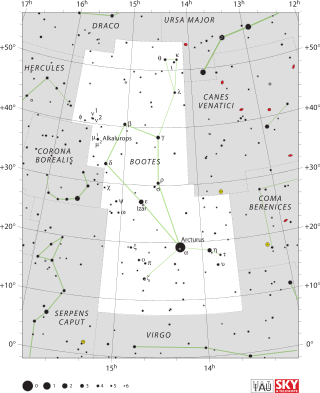
The Tau Herculids are a meteor shower that when discovered in 1930 appeared to originate from the star Tau Herculis. The parent comet of the Tau Herculids is periodic comet Schwassmann-Wachmann 3 with a 5.4 year orbital period. This meteor shower occurs from May 19 - June 19. The meteor shower was first observed by the Kwasan Observatory in Kyoto, Japan in May 1930. The Tau Herculids' average radiant was α=236°, δ=+41°. Due to orbital perturbations of the meteor streams by Jupiter, 2022 activity will have a radiant of R.A. = 13:56 (209), Decl. = +28. The meteors are relatively slow moving making atmospheric entry at around 16 km/s (36,000 mph).

A potentially hazardous object (PHO) is a near-Earth object – either an asteroid or a comet – with an orbit that can make close approaches to the Earth and which is large enough to cause significant regional damage in the event of impact. They are conventionally defined as having a minimum orbit intersection distance with Earth of less than 0.05 astronomical units and an absolute magnitude of 22 or brighter, the latter of which roughly corresponds to a size larger than 140 meters. More than 99% of the known potentially hazardous objects are no impact threat over the next 100 years. As of September 2022, just 17 of the known potentially hazardous objects listed on the Sentry Risk Table could not be excluded as potential threats over the next hundred years. Over hundreds if not thousands of years though, the orbits of some "potentially hazardous" asteroids can evolve to live up to their namesake.
1994 WR12 is an asteroid and near-Earth object approximately 130 meters (430 feet) in diameter. As a member of the Aten group almost all of its orbit is closer to the Sun than Earth is. On 24 November 1994 it passed about 374100 km from the Moon. First imaged at Kitami Observatory on 26 November 1994, it was discovered two nights later by American astronomer Carolyn S. Shoemaker at Palomar Observatory on 28 November 1994. The asteroid then went unobserved from 1994 until it was recovered by Mauna Kea in March 2016. It was removed from the Sentry Risk Table on 2 April 2016.
2010 RF12 is a very small asteroid, classified as near-Earth object of the Apollo group, that passed between Earth and the Moon on 8 September 2010, at 21:12 UTC, approaching Earth within 79,000 kilometres (49,000 mi) above Antarctica. The asteroid was discovered by the Mount Lemmon Survey near Tucson, Arizona on 5 September 2010 along with 2010 RX30. Based on a short 7-day observation arc from that apparation, it was listed for 12 years on the Sentry Risk Table as the asteroid with the greatest known probability (5%) of impacting Earth. 2010 RF12 was rediscovered in August 2022, and now has a 12-year observation arc and a much better known orbit. As of the December 2022 solution which accounts for nongravitational forces, there is a 1-in-10 chance of an Earth impact on 5 September 2095.
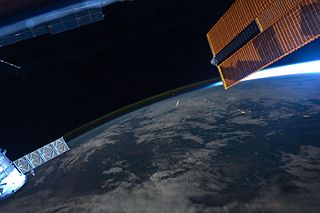
Comet Swift–Tuttle is a large periodic comet with a 1995 (osculating) orbital period of 133 years that is in a 1:11 orbital resonance with Jupiter. It fits the classical definition of a Halley-type comet, which has an orbital period between 20 and 200 years. The comet was independently discovered by Lewis Swift on July 16, 1862 and by Horace Parnell Tuttle on July 19, 1862.
(471240) 2011 BT15, provisional designation 2011 BT15, is a stony, sub-kilometer sized asteroid and fast rotator, classified as a near-Earth object and potentially hazardous asteroid of the Apollo group. It had been one of the objects with the highest impact threat on the Palermo Technical Impact Hazard Scale.

2019 MO, temporarily designated A10eoM1, was a small, harmless 3-meter near-Earth asteroid discovered by ATLAS–MLO that impacted Earth's atmosphere on 22 June 2019 at 21:25 UT. The impact of the bolide generated a 5-kiloton-equivalent explosion off the south coast of Puerto Rico which was detected by infrasound detectors. The strewn field would be spread over the Caribbean Sea.
2018 VP1 is an Apollo near-Earth asteroid roughly 2 meters (7 feet) in diameter. The asteroid had a 0.41% chance (1 in 240) of impacting Earth on 2 November 2020 01:12 UT. It was discovered on 3 November 2018 when it was about 0.003 AU (450,000 km; 280,000 mi) from Earth and had a solar elongation of 165 degrees. The asteroid has a short 12.9 day observation arc. It was last observed on 16 November 2018 by the European Southern Observatory Very Large Telescope at apparent magnitude 26 pushing the telescope close to the limiting magnitude.

CAMS is a NASA-sponsored international project that tracks and triangulates meteors during night-time video surveillance in order to map and monitor meteor showers. Data processing is housed at the Carl Sagan Center of the SETI Institute in California, USA. Goal of CAMS is to validate the International Astronomical Union's Working List of Meteor Showers, discover new meteor showers, and predict future meteor showers.

C/1939 H1 (Jurlof–Achmarof–Hassel) is a long-period comet discovered on 15 April 1939. The comet was discovered by many observers independently but the first reports were those of Olaf Hassel, Achmarof, and Jurlof. The comet had a magnitude of 3 upon discovery.

C/1911 N1 (Kiess) is a non-periodic comet discovered by Carl Clarence Kiess on 6 July 1911. The comet has been identified as the parent body of the Aurigids meteor shower.
References
- 1 2 "MPEC 2005-J29 : 2005 JQ5". IAU Minor Planet Center. 8 May 2005. Retrieved 5 July 2019. (K05J05Q)
- 1 2 3 "300P/Catalina Orbit". Minor Planet Center . Retrieved 5 July 2019.
- ↑ "Horizons Batch for 300P/Catalina (90001248) on 2027-Sep-13" (Perihelion occurs when rdot flips from negative to positive). JPL Horizons . Retrieved 2 May 2023. (Soln.date: 2023-Apr-25)
- 1 2 3 "JPL Small-Body Database Browser: 300P/Catalina" (last observation: 2019-01-01). Jet Propulsion Laboratory . Retrieved 5 July 2019.
- 1 2 3 Harmon; Nolan; Margot; Campbell; Benner; Giorgini (2005). "Radar observations of Comet P/2005 JQ5 (Catalina)". Icarus . 184 (1): 285–288. arXiv: 0712.4204 . Bibcode:2006Icar..184..285H. doi:10.1016/j.icarus.2006.05.014.
- ↑ David L Chandler (1 June 2005). "Comet put on list of potential Earth impactors". New Scientist . Retrieved 5 July 2019.
- ↑ "Sentry Risk Table Archive". NASA/JPL Near-Earth Object Program Office. Archived from the original on 10 May 2005. Retrieved 5 July 2019.
- ↑ "CRT 2005 Object Archive". hohmanntransfer. Archived from the original on 15 June 2011. Retrieved 5 July 2019.
- ↑ Andy Howell (3 July 2019). "CAMS Observes Outburst of the June Epsilon Ophiuchid Meteors". Meteor News. Retrieved 5 July 2019.
- 1 2 Paul Roggemans (7 July 2019). "June Epsilon Ophiuchids (JEO#459), 2019 Outburst and an Impactor?". Meteor News. Retrieved 8 July 2019.
- ↑ "June Epsilon Ophiuchid Meteors". Central Bureau for Astronomical Telegrams. 29 June 2019. Retrieved 5 July 2019.

